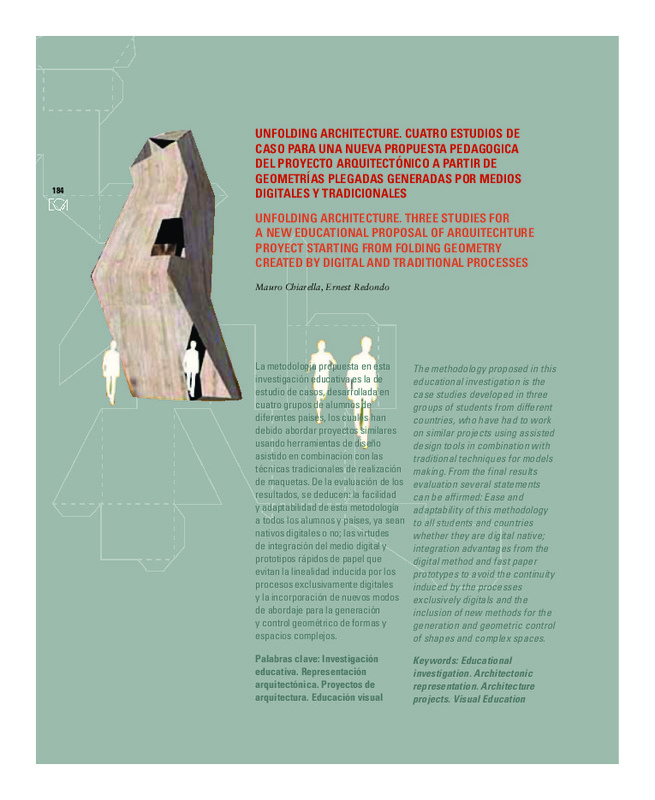JavaScript is disabled for your browser. Some features of this site may not work without it.
Buscar en RiuNet
Listar
Mi cuenta
Estadísticas
Ayuda RiuNet
Admin. UPV
UNFOLDING ARCHITECTURE. CUATRO ESTUDIOS DE CASO PARA UNA NUEVA PROPUESTA PEDAGOGICA DEL PROYECTO ARQUITECTÓNICO A PARTIR DE GEOMETRÍAS PLEGADAS GENERADAS POR MEDIOS DIGITALES Y TRADICIONALES
Mostrar el registro sencillo del ítem
Ficheros en el ítem
| dc.contributor.author | Chiarella, Mauro
|
es_ES |
| dc.contributor.author | Redondo, Ernest
|
es_ES |
| dc.date.accessioned | 2013-02-05T07:59:03Z | |
| dc.date.available | 2013-02-05T07:59:03Z | |
| dc.date.issued | 2012 | |
| dc.identifier.issn | 1133-6137 | |
| dc.identifier.uri | http://hdl.handle.net/10251/19208 | |
| dc.description.abstract | [EN] The methodology proposed in this educational investigation is the case studies developed in three groups of students from different countries, who have had to work on similar projects using assisted design tools in combination with traditional techniques for models making. From the final results evaluation several statements can be affirmed: Ease and adaptability of this methodology to all students and countries whether they are digital native; integration advantages from the digital method and fast paper prototypes to avoid the continuity induced by the processes exclusively digitals and the inclusion of new methods for the generation and geometric control of shapes and complex spaces. | es_ES |
| dc.description.abstract | [ES] La metodología propuesta en esta investigación educativa es la de estudio de casos, desarrollada en cuatro grupos de alumnos de diferentes países, los cuales han debido abordar proyectos similares usando herramientas de diseño asistido en combinación con las técnicas tradicionales de realización de maquetas. De la evaluación de los resultados, se deducen: la facilidad y adaptabilidad de esta metodología a todos los alumnos y países, ya sean nativos digitales o no; las virtudes de integración del medio digital y prototipos rápidos de papel que evitan la linealidad inducida por los procesos exclusivamente digitales y la incorporación de nuevos modos de abordaje para la generación y control geométrico de formas y espacios complejos. | es_ES |
| dc.language | Español | es_ES |
| dc.publisher | Editorial Universitat Politècnica de València | es_ES |
| dc.relation.ispartof | EGA. Revista de Expresión Gráfica Arquitectónica | |
| dc.rights | Reserva de todos los derechos | es_ES |
| dc.subject | Investigación educativa | es_ES |
| dc.subject | Representación arquitectónica | es_ES |
| dc.subject | Proyectos de arquitectura | es_ES |
| dc.subject | Educación visual | es_ES |
| dc.subject | Educational investigation | es_ES |
| dc.subject | Architectonic representation | es_ES |
| dc.subject | Architecture projects | es_ES |
| dc.subject | Visual education | es_ES |
| dc.title | UNFOLDING ARCHITECTURE. CUATRO ESTUDIOS DE CASO PARA UNA NUEVA PROPUESTA PEDAGOGICA DEL PROYECTO ARQUITECTÓNICO A PARTIR DE GEOMETRÍAS PLEGADAS GENERADAS POR MEDIOS DIGITALES Y TRADICIONALES | es_ES |
| dc.title.alternative | UNFOLDING ARCHITECTURE. THREE STUDIES FOR A NEW EDUCATIONAL PROPOSAL OF ARQUITECHTURE PROYECT STARTING FROM FOLDING GEOMETRY CREATED BY DIGITAL AND TRADITIONAL PROCESSES | es_ES |
| dc.type | Artículo | es_ES |
| dc.date.updated | 2013-01-24T09:02:54Z | |
| dc.identifier.doi | 10.4995/ega.2011.1093 | |
| dc.rights.accessRights | Abierto | es_ES |
| dc.description.bibliographicCitation | Chiarella, M.; Redondo, E. (2012). UNFOLDING ARCHITECTURE. CUATRO ESTUDIOS DE CASO PARA UNA NUEVA PROPUESTA PEDAGOGICA DEL PROYECTO ARQUITECTÓNICO A PARTIR DE GEOMETRÍAS PLEGADAS GENERADAS POR MEDIOS DIGITALES Y TRADICIONALES. EGA. Revista de Expresión Gráfica Arquitectónica. 16(18):184-191. https://doi.org/10.4995/ega.2011.1093 | es_ES |
| dc.description.accrualMethod | SWORD | es_ES |
| dc.relation.publisherversion | https://doi.org/10.4995/ega.2011.1093 | es_ES |
| dc.description.upvformatpinicio | 184 | |
| dc.description.upvformatpfin | 191 | |
| dc.description.volume | 16 | |
| dc.description.issue | 18 | |
| dc.identifier.eissn | 2254-6103 |








